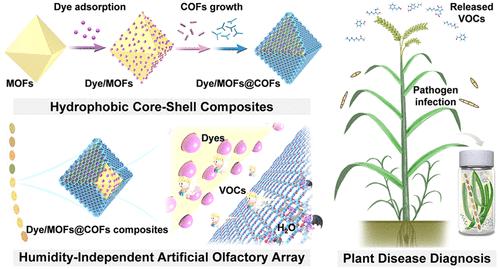Our official English website, www.x-mol.net, welcomes your
feedback! (Note: you will need to create a separate account there.)
Humidity-Independent Artificial Olfactory Array Enabled by Hydrophobic Core–Shell Dye/MOFs@COFs Composites for Plant Disease Diagnosis
ACS Nano ( IF 15.8 ) Pub Date : 2022-08-31 , DOI: 10.1021/acsnano.2c04457 Xiao Wang 1, 2 , Yixian Wang 1, 2 , Hao Qi 3, 4 , Yun Chen 3, 4 , Wei Guo 5 , Haiyan Yu 5 , Huayun Chen 1, 2 , Yibin Ying 1, 2
ACS Nano ( IF 15.8 ) Pub Date : 2022-08-31 , DOI: 10.1021/acsnano.2c04457 Xiao Wang 1, 2 , Yixian Wang 1, 2 , Hao Qi 3, 4 , Yun Chen 3, 4 , Wei Guo 5 , Haiyan Yu 5 , Huayun Chen 1, 2 , Yibin Ying 1, 2
Affiliation

|
As a class of important artificial olfactory system, the colorimetric sensor array possesses great potential for commercialization due to its cost-effectiveness and portability. However, when applied to practical applications, the humidity interference from ambient environment and dissatisfactory sensitivity for trace target VOCs are largely unsolved problems. To overcome the problems, we developed a series of dye/MOFs@COFs gas-sensing materials with core–shell structure using a hydrophobization strategy by encapsulation of dye/metal–organic frameworks (MOFs) into hydrophobic covalent organic frameworks (COFs). Benefiting from the hydrophobic property of the COF shell, the dye/MOFs@COFs composites were endowed with excellent humidity-resistance even under 100% relative humidity (RH). Moreover, due to the uniform distribution of dyes on the porous MOFs, the dye/MOFs@COFs sensors also exhibited improved sensitivity at the sub-ppm level, compared with conventional dye sensors. On basis of the excellent humidity-resistance and improved sensitivity, an artificial olfactory array based on dye/MOFs@COFs composites was proven to be a successful practical application in early and accurate detection of wheat scab (1 day after inoculation) by monitoring its released VOC markers. The synthetic strategy for core–shell dye/MOFs@COFs is applicable to a wide range of colorimetric sensor arrays, endowing them with excellent humidity-resistance and sensitivity for the feasibility of practical applications.
中文翻译:

疏水核壳染料/MOFs@COFs复合材料实现的湿度无关的人工嗅觉阵列用于植物病害诊断
作为一类重要的人工嗅觉系统,比色传感器阵列由于其成本效益和便携性而具有巨大的商业化潜力。然而,在实际应用中,周围环境的湿度干扰和痕量目标VOCs的灵敏度不理想等问题很大程度上是未解决的问题。为了克服这些问题,我们开发了一系列具有核壳结构的染料/MOFs@COFs 气敏材料,采用疏水化策略,将染料/金属有机骨架(MOFs)封装到疏水共价有机骨架(COFs)中。得益于 COF 壳的疏水性,染料/MOFs@COFs 复合材料即使在 100% 相对湿度 (RH) 下也具有出色的耐湿性。而且,由于染料在多孔 MOF 上的均匀分布,与传统染料传感器相比,染料/MOFs@COFs 传感器在亚 ppm 水平上也表现出更高的灵敏度。基于染料/MOFs@COFs复合材料的人工嗅觉阵列具有优异的耐湿性和更高的灵敏度,通过监测其释放量,在小麦黑星病早期准确检测(接种后1天)方面取得了成功的实际应用。 VOC 标记。核壳染料/MOFs@COFs的合成策略适用于广泛的比色传感器阵列,使其具有优异的耐湿性和灵敏度,具有实际应用的可行性。基于染料/MOFs@COFs复合材料的人工嗅觉阵列具有优异的耐湿性和更高的灵敏度,通过监测其释放量,在小麦黑星病早期准确检测(接种后1天)方面取得了成功的实际应用。 VOC 标记。核壳染料/MOFs@COFs的合成策略适用于广泛的比色传感器阵列,使其具有优异的耐湿性和灵敏度,具有实际应用的可行性。基于染料/MOFs@COFs复合材料的人工嗅觉阵列具有优异的耐湿性和更高的灵敏度,通过监测其释放量,在小麦黑星病早期准确检测(接种后1天)方面取得了成功的实际应用。 VOC 标记。核壳染料/MOFs@COFs的合成策略适用于广泛的比色传感器阵列,使其具有优异的耐湿性和灵敏度,具有实际应用的可行性。
更新日期:2022-08-31
中文翻译:

疏水核壳染料/MOFs@COFs复合材料实现的湿度无关的人工嗅觉阵列用于植物病害诊断
作为一类重要的人工嗅觉系统,比色传感器阵列由于其成本效益和便携性而具有巨大的商业化潜力。然而,在实际应用中,周围环境的湿度干扰和痕量目标VOCs的灵敏度不理想等问题很大程度上是未解决的问题。为了克服这些问题,我们开发了一系列具有核壳结构的染料/MOFs@COFs 气敏材料,采用疏水化策略,将染料/金属有机骨架(MOFs)封装到疏水共价有机骨架(COFs)中。得益于 COF 壳的疏水性,染料/MOFs@COFs 复合材料即使在 100% 相对湿度 (RH) 下也具有出色的耐湿性。而且,由于染料在多孔 MOF 上的均匀分布,与传统染料传感器相比,染料/MOFs@COFs 传感器在亚 ppm 水平上也表现出更高的灵敏度。基于染料/MOFs@COFs复合材料的人工嗅觉阵列具有优异的耐湿性和更高的灵敏度,通过监测其释放量,在小麦黑星病早期准确检测(接种后1天)方面取得了成功的实际应用。 VOC 标记。核壳染料/MOFs@COFs的合成策略适用于广泛的比色传感器阵列,使其具有优异的耐湿性和灵敏度,具有实际应用的可行性。基于染料/MOFs@COFs复合材料的人工嗅觉阵列具有优异的耐湿性和更高的灵敏度,通过监测其释放量,在小麦黑星病早期准确检测(接种后1天)方面取得了成功的实际应用。 VOC 标记。核壳染料/MOFs@COFs的合成策略适用于广泛的比色传感器阵列,使其具有优异的耐湿性和灵敏度,具有实际应用的可行性。基于染料/MOFs@COFs复合材料的人工嗅觉阵列具有优异的耐湿性和更高的灵敏度,通过监测其释放量,在小麦黑星病早期准确检测(接种后1天)方面取得了成功的实际应用。 VOC 标记。核壳染料/MOFs@COFs的合成策略适用于广泛的比色传感器阵列,使其具有优异的耐湿性和灵敏度,具有实际应用的可行性。

































 京公网安备 11010802027423号
京公网安备 11010802027423号